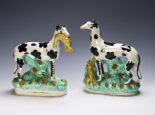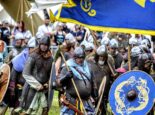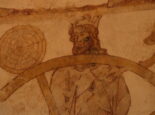Steam along the Nene
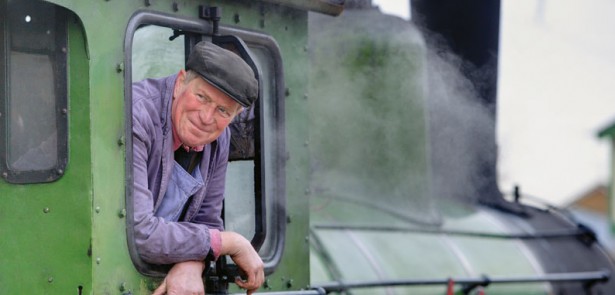
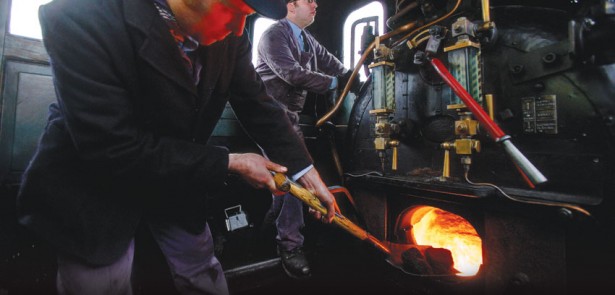
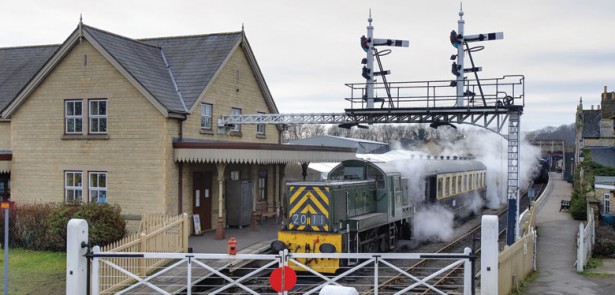
One of this region’s biggest tourist draws is the Nene Valley Railway, running from Peterborough to Wansford and Yarwell. Yet, even if you’ve never been, you’re probably already quite familiar with it. RICHARD GUNN explains why and also explores the history of the line as well as meeting some of the vital people who make it all happen.
We’ll start with a question. Can you name any major films or television shows in which Peterborough and its surrounding district have played a prominent role? Answers probably don’t flow that readily – after all, the city has yet to achieve the same celluloid glamour of London, Paris or New York – but, since 1977, getting on for 200 movies, commercials and TV episodes have been staged in a particular part of the area. There have been two Bond movies, Steven Spielberg’s Band of Brothers, Agatha Christie’s Hercule Poirot has been a regular visitor, pop groups have filmed promo videos and there have been countless major incidents on behalf of Casualty, EastEnders, Dalziel and Pasco, London’s Burning and The Bill.
Riding on the Nene Valley Railway is fun for all, but children especially love this travel experience from a different age
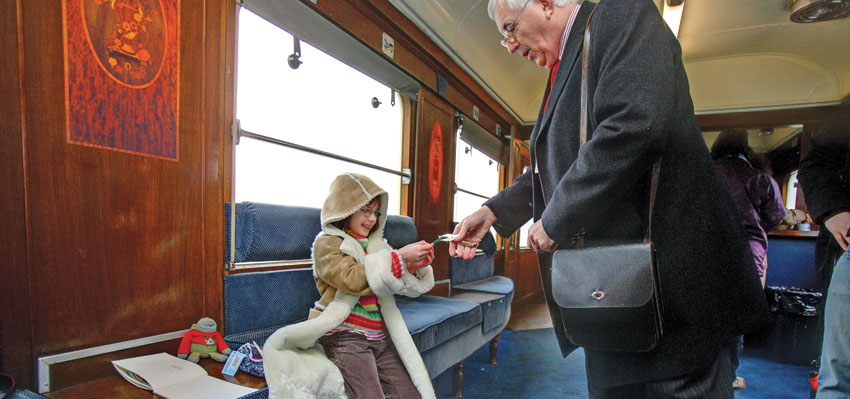 But if urban and rural Cambridgeshire in the background haven’t seemed obvious, that’s probably because, quite often, the locations have been masquerading as somewhere else in the world. Over the last 34 years, Peterborough, Wansford and several points between the two have pretended to be Germany, France, Denmark and Russia, as well as numerous different UK localities. And the reason for this pseudonymous celebrity status is the Nene Valley Railway, the preserved line that runs from near the centre of Peterborough, out alongside the river, through Ferry Meadows Country Park and onto Wansford and Yarwell. The seven and a half mile route has become one of the country’s premier historic railways since it opened in 1977. However, some of its appeal lies not in its Britishness, but quite the opposite. For the railway is unique in Europe; it operates rolling stock and coaches from 10 different countries, allowing it to switch identity to anywhere it – or rather, those with the cameras – want it to be. But aside from its starring roles, the railway also functions as one of Peterborough’s main tourist and family attractions, operating all year round. Since it opened as an independent heritage railway, over a million people have visited and travelled on the line. Although how many of them have actually recognised it, despite the fact they’ve probably seen it on the large or small screen many times?
But if urban and rural Cambridgeshire in the background haven’t seemed obvious, that’s probably because, quite often, the locations have been masquerading as somewhere else in the world. Over the last 34 years, Peterborough, Wansford and several points between the two have pretended to be Germany, France, Denmark and Russia, as well as numerous different UK localities. And the reason for this pseudonymous celebrity status is the Nene Valley Railway, the preserved line that runs from near the centre of Peterborough, out alongside the river, through Ferry Meadows Country Park and onto Wansford and Yarwell. The seven and a half mile route has become one of the country’s premier historic railways since it opened in 1977. However, some of its appeal lies not in its Britishness, but quite the opposite. For the railway is unique in Europe; it operates rolling stock and coaches from 10 different countries, allowing it to switch identity to anywhere it – or rather, those with the cameras – want it to be. But aside from its starring roles, the railway also functions as one of Peterborough’s main tourist and family attractions, operating all year round. Since it opened as an independent heritage railway, over a million people have visited and travelled on the line. Although how many of them have actually recognised it, despite the fact they’ve probably seen it on the large or small screen many times?
The History of Nene Valley Railway
The line that now forms the Nene Valley Railway was the earliest to reach Peterborough, with the first train leaving the city on June 2, 1845. The route to London was quite a tortuous one; from a station on the eastern side of the Town Bridge (one platform of which still remains, although the palatial buildings have long since gone) out to Wansford, onto Northampton and from there to Euston. Visit that London terminus now and, on one of the two Victorian lodges that stood either side of its famous but now demolished Euston Arch, you’ll still see Peterborough inscribed as a destination on the stonework.
The London and Birmingham Railway started building its line to Peterborough in 1843. Trains were still new and radical at the time and not everybody approved of them. Some local landowners were up in arms, although it seems that God was at least on the side of the L&BR, for an important supporter was the Bishop of Peterborough. The company overcame the objections however, and the line was remarkably completed in little over a year, at a very reasonable cost of £429,409.
The biggest undertaking was the 617-yard Wansford Tunnel, still a feature of the Nene Valley Railway today. The scale of the task was marked by the difference in wages; normal labourers got 12 shillings a week, those on tunnel work got an impressive 30. Thanks to the area being one of the UK’s main brick-making centres, the bricks to construct it were made from local clay rather brought in, which undoubtedly helped keep costs down. However, the large number of navvies – by the summer of 1844, there were 1000 in the area – did bring some social problems. Peterborough even had to reinforce its police force, from four men up to five! A further two officers were seconded from Manchester to help keep the peace amid the earth huts that the workers lived in around Wansford.
Around 8000 people turned out to greet the first train, at a time when Peterborough’s total population was only 7000. A second train, in the afternoon, brought even more people. So when the time came for the crowds to disperse – naturally with a large number deciding to go by the new-fangled railway – it turned into chaos. The return service was packed beyond capacity, so much so that fights broke out and passengers took to the carriage roofs. In a move that would give a modern Health & Safety officer apoplexy, the train left with people actually still on top of the carriages. The guard apparently stopped the service before any low bridges so he could warn those overhead to keep their heads down. It was ‘gratifying everything had passed off so pleasantly’ reported the Stamford Mercury with none of the tabloid hysteria that would no doubt surround such an incident today.
The total travelling time to London was about five hours, but this was still much faster than the capital could have been reached previously, by coach or horse. In 1846 the London and Birmingham Railway was taken over by the larger London and North Western Railway, resulting in it also gaining control of the Peterborough branch. But rival companies were already threatening the L&NWR’s dominance of the city. Other lines soon arrived, and by 1847, there was a competing way to London, courtesy of the Eastern Counties Railway’s new route via March and Ely. In 1850, the Great Northern Railway opened its direct line to London, terminating at Maiden Lane in Islington as King’s Cross Station was still two years away from completion.
While this robbed the Peterborough to Northampton railway of some of its prosperity and importance, it continued to do well. Wansford became a junction in 1867 with the opening of a line to Stamford and in 1879, there was a further extension, offering direct access to Rugby. In fact, it allowed more than that, since the continuing spider’s web of lines allowed passengers from Peterborough to get to North Wales and, via ship, to Ireland. Finally, in 1883, a connection was added to the Great Northern Railway’s East Coast Main Line, at Fletton.
In 1923, the London, Midland and Scottish Railway took over control, although most of the rest of the network around Peterborough was operated by the rival London and North Eastern Railway. During the Second World War, Castor Station on the line was damaged by a V1 ‘Doodlebug’ flying bomb that landed nearby, launched from a Heinkel H111 bomber over Wisbech. A few years after the hostilities came to an end, the rail network was nationalised into British Railways, in 1948. But, by then, usage was declining, a trend that would only accelerate thanks to the growth of car ownership, and the route was one of many to feel the effects of this. Wansford Station closed in 1957, passenger services through to Northampton ended in 1964 and those to Rugby ceased in 1966. The line continued for freight, and there was even the occasional special for Oundle School pupils, but in 1972, British Rail closed the line completely.
Preservation
By this time, the nucleus that would grow into the Nene Valley Railway had already formed. When steam was withdrawn from BR in 1968, a local clergyman, Richard Patten, purchased a Class 5 steam loco for scrap value. The intention was to have the engine, numbered 73050, on display outside Peterborough’s technical college. However, it was in such good order that it managed to travel from Manchester to Peterborough under its own power, despite a ban on steam. The trip took place, surreptitiously by night, a month after the last official steam services had operated on the UK’s network. The decision was taken to restore the loco – which was only then 14 years old – to full working order instead. In 1970, the Peterborough Locomotive Society was formed by enthusiasts to do just that.
Restoration started at Baker Perkins Ltd, before the locomotive was moved to the British Sugar Corporation’s factory, off Oundle Road, adjacent to what would become the Nene Valley Railway. This had its own internal rail system and was the home of Thomas, a small blue tank engine named by the Reverend Wilbur Awdry in 1971. The Reverend Awdry was famous for his books about a certain other blue tank engine by the name of Thomas, plus his friends of course, and the locomotive he christened remains on the NVR to this day, bringing much joy and delight to young visitors. Around this time, Peterborough’s City Council and the County Council submitted a plan to the government to site the National Railway Museum in the city. Ultimately, Peterborough lost out to York, but the side-proposal of turning the line along the River Nene into a heritage route persisted. Following a positive public meeting in 1972, the PLS became the Peterborough Railway Society and pressed on with this scheme, supported by Peterborough Development Corporation and the relevant councils. Two years after that British Rail shut the line, the Development Corporation bought the section between Longueville and Yarwell to lease to the PRS.
The original Thomas; one of the Nene Valley Railways small blue tank engines was named by the creator of the popular children’s books. No wonder this locomotive has been very popular with youngsters ever since
For the volunteers of the PRS, the task ahead was enormous. Many of the stations had been knocked down and maintenance neglected for years. There was no connection to the mainline network or even to the British Sugar Factory’s site where the society stored its stock, including 73050. Wansford station and its adjacent yard were now in private hands. Getting any sort of train service going again was going to be extremely tough.
One member of the PRS offered the use of his ex-Swedish Railways steam locomotive. Foreign stock however is built to a larger size (loading gauge) than its British equivalent. That meant the engine couldn’t be used on the line as it was. However, a survey of the route revealed that, with some platform alterations and the demolition of a bridge, the Nene Valley line could accommodate continental trains as well as traditional British fare.
Wansford was chosen as the main base of operations, with a shuttle service through Wansford Tunnel – the longest on a UK preserved line – beginning in 1975. The upgrading of the rest of the line for passenger traffic, as far as Orton Mere Station, took until May 1977. Locomotives from Britain, Denmark and France arrived, along with enough carriages to mean that, on June 4, 1977, the Nene Valley Railway was able to start operating its own public services.
There were still lots of obstacles to overcome, such as the lack of facilities – for visitors and staff alike – at Wansford and the fact that the eastern Orton Mere terminus was far from satisfactory. Many visitors unfamiliar to Peterborough couldn’t even find it! Improvements were gradual, as and when finances allowed. A locomotive turntable was installed at Wansford in 1978, and in 1980, a weekend British Rail shuttle service started operating between Peterborough’s mainline station and Orton Mere. An extension to Yarwell opened in 1983, as did an additional shed at Wansford, in addition to the locomotive accommodation constructed in 1980.
For 1984, an appeal was launched to expand the line properly into Peterborough. This was achieved in 1986 when the first passenger train ran to Peterborough Nene Valley Station, on the south side of the river and within easy walking distance of the centre. At last, it gave the Nene Valley Railway a proper eastern terminus, plus a total round trip length of 15 miles. The new stretch was opened by Prince Edward who, the summer before, had been tied to the track in front of a locomotive. It’s perhaps not often such an encounter would encourage a member of the Royal Family to return, but Edward was a Cambridge University student at the time and the whole thing was a Rag Week stunt.
The improvements continued into the next decade. In 1995, the impressive Wansford Station building was opened at a cost of £250,000. It was brand new yet designed to blend in with the existing, much older structures on the site. Three years later, Ferry Meadows got new station as well. Well, sort of. This one was a genuine original railway structure, albeit actually the 1900 Great Northern Railway goods office from Fletton High Street in Peterborough!
The big project of the 21st century, so far at least, has been the construction of a new station at Yarwell, but there are even grander schemes ahead. As well as a Night Mail and Wagon-Lit museum planned adjacent to Ferry Meadows, there are ambitious hopes to purchase and restore the original Wansford Station building, which date back to 1845. The plan is to use the ornate Jacobean-style structure as a museum, although the building itself will require extensive repairs before that can happen. It’s likely to be an uphill struggle for the railway to achieve this major aim. But if there’s one thing the NVR has proved over the last 34 years, it’s that, when it comes to challenges, the railway is more than up to the task of overcoming them.
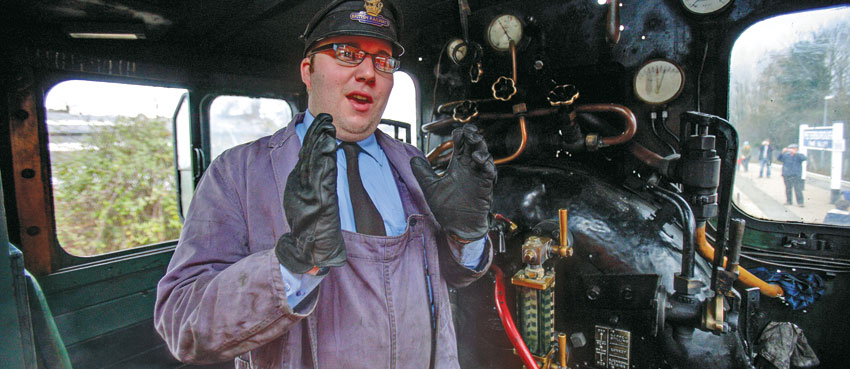 The Railway Today
The Railway Today
Today, the Nene Valley Railway provides services 11 months of the year, from Santa Specials in December though to daily trains during the school summer holiday months. The Moment spent a day there and discovered that it is so much more than just a bunch of amateur enthusiasts playing full size model railways. As David Hickling, a director, booking/ticket office manager and the tour/group co-ordinator explains, “We’re governed by the Railway Inspectorate and have to comply with all the rules and regulations.” Although it is classed as a light railway, with a maximum speed limit of 25mph throughout, it has to conform to much of the same criteria as the main East Coast Main Line that passes by it at Peterborough…despite the fact that the ECML sees trains operating at speeds of up to 100mph more than on the NVR.
The vast majority of those who make this preserved line possible are volunteers
There are around a thousand NVR members, but not all of those work on the line. However, around 200 do give their time and effort for free, in addition to the 10 paid employees. The duties they cover include steam and diesel locomotive driving, catering on and off trains, manning the station shop, museum and secondhand bookshop, signalling, rolling stock maintenance and restoration, civil engineering, ticket sales and general duties. On a typical day, 25 to 30 volunteers are required to operate the system; this rises to 40 during the peak summer months. The busiest time of all is throughout December, when the Santa Specials run. It takes 80 people to run these trains; distributing mince pies and drinks to adults, sweets to the children and, of course, somebody has to be Father Christmas as well. However, around 17,000 to 18,000 passengers travel on these services, a significant proportion of the 65,000 people who visit the Nene Valley Railway each year. “They need a lot of preparation,” says David. And, when much of the rest of Britain’s rail network was disrupted by snow at the end of December, the Santa Specials still kept going, although some of the steam locomotives did have to have fires lit under them to thaw their frozen pipes. “Actually, we did have one train that was 20 minutes late,” admits David. “But that was it. Eurostar wasn’t running. But we were!”
Volunteers are always needed, especially if the NVR’s ambitious plans come to fruition. Because the railway is a charitable trust, it needs to support itself to survive. And although, for big projects, it can apply for lottery money, for day-to-day running, it has to cover its costs. “Everything has to be worked for, to pay our finances,” clarifies David. The hope is to increase passenger numbers by 10 per cent year-on-year. So far, that ideal has got off to a roaring start; 2010 saw that level of improvement, something David actually puts down to Britain’s troubled economic situation. “We had a few more people here the last summer because a lot of people didn’t go away. There’s no other heritage railway between here and London, which also helped.”
Initiatives to boost visitors include diesel galas – heritage diesel locomotives now have almost as keen a following as steam among enthusiasts – as well as fish and chip specials, a Steamin’ Blues evening and vintage vehicle weekends. “The biggest event of the year though, I think, is the 1940s Weekend in September,” says David. This wartime recreation sees “people dressed up in military uniform or period civilian dress, we usually have a tank here, and there are re-enactments of battles and soldiers storming a train.” A new idea for 2011 is a Waitrose Wine Special which will do exactly what it says on the tin (or rather, the bottle); wine-tasting in the homely comfort of a moving railway coach, while somebody else does the driving. There are also group tours for coach parties, including a meal on a train and a tour of local villages in a classic Routemaster London bus. And, for those wanting to celebrate Guy Fawkes Night with fire right from the start, the NVR now runs trains to Peterborough’s main fireworks display at Ferry Meadows. Last year, its services carried 850 people to the bonfire and bangs, with style, steam and smoke.
You can even get married on the Nene Valley Railway. “We have four to five weddings a year, in 2010 we did our first civil partnership,” explains David. A popular location for unions to take place is in one of the NVR’s vintage wood-panelled coaches from Norway. Receptions then take place on a train travelling up and down the line. Of course, if you don’t want to go the whole hog and get hitched, then the railway also caters for ordinary parties as well, tailor-made for the requirements of those attending. The NVR’s president, David Smith, who has been with the railway since the 1970s, tells the story of one retiring headmaster who was renowned for blowing a whistle to attract his pupils’ attention. At his leaving party on the railway, they turned out to pipe him aboard the train with a special chorus…of their own whistles!
Other activities include steam and diesel locomotive driving experiences – and yes, you can bring along your friends to haul behind you in a coach if you want – as well as the chance to practice being a signalman. Be prepared though; you’ll need strong muscles. Don Crick, who has worked on the NVR for 31 years, was on duty during The Moment’s visit to the 1907 Wansford signal box. This is one of the largest preserved boxes still in its original location and formerly the cause of a notorious bottleneck on the pre-diversion A1 Great North Road, thanks to its adjacent crossing gates controlled by a big wheel inside. It earned further notoriety for the number of road vehicles that used to crash through the barriers in bad weather. The box still controls most of its signals and points by the traditional method of large cable-connected mechanical levers and Don demonstrated just how much strength is needed by letting us try one to move a distant signal. It’s not an easy task; you need to pull down a locking ring and then heave the lever towards you with as much force as you can muster, using a wooden ledge on the floor to give your feet extra leverage. Who needs a gym workout when you can be controlling trains on the Nene Valley Railway instead? “There’s a knack to all of these,” says Don with masterful understatement.
While driving the trains may seem the glamorous and exciting part of working on a preserved railway, few people get to do this because of the extensive training involved; it can take six years to become a fireman and 10 years to graduate to being a driver. Other jobs are just as vital to the smooth operation of the NVR. Behind the scenes, away from public view, a small army of volunteers beaver away to keep current locomotives and rolling stock running, with general maintenance, as well as ensure that restoration continues on the next generation of NVR locos, carriages and wagons. John Whitby is the man responsible for overseeing a lot of this, as the mechanical engineering supervisor. He’s been in the role for six months. While his background is in organising corporate conferences – not something that generally prepares somebody for working on 80-odd tons of steam locomotive – he’s built functional models of engines for much of his life. “So, I used to build one inch to the foot scale models, now I’ve moved up to 12 inches to the foot.” He works with a staff of four people full-time and two part-time, supplemented by other NVR volunteers and those from the various societies plus individuals who use the line as a base for their own items. Wansford is the site of the railway’s two maintenance sheds. They’re not usually open to visitors, although the New Shed, constructed a few years ago, is in the process of having viewing galleries installed.
And there should be much to see. A major project is the total overhaul of Bulleid Pacific No 34081 92 Squadron, an express steam loco used on British Railways’ Southern Region from 1948 to 1964. Owned by the Battle of Britain Locomotive Society, the engine is currently little more than a shell at the moment, as its rebuild continues. £200,000 has been raised so far towards getting it back into service, but the eventual cost is likely to be between £500,000 and £600,000, coming via donations. Also in the sheds are the last surviving mail coach from the Great Train Robbery of 1963, as well as a Class 40 diesel, D306 Atlantic Conveyer, which was used in the 1988 movie Buster telling the tale of that notorious event. Then there’s the reconstruction of a brake van that had been completely burnt out from the metal wheel-frame upwards. Its wooden body is now largely complete. “We called it the IKEA van, because it came in flat-packed,” laughs John.
Another regular at Wansford’s sheds is Allan Nunn, along with fiancée Antonia Ashford-Hodges. Although Allan is only 24, he owns 13 ex-British Railways Mk1 coaches, one of which the Cambridge couple are in the final stages of renovating to use on the NVR. “I bought a carriage because I couldn’t afford a locomotive,” says Allan of the maroon item from the late-1950s. “Locos cost £30,000, this was £3000. But it has cost about £6500 to restore.” Allan, who has been into railways since he was four, works at the NVR site one weekend out of every three. “I can’t be away from steam for any more than two weeks,” he chuckles. His enthusiasm is obviously infectious. Antonia points out that she “didn’t realise these sort of things existed” before she met Allan, but only recently, she’d started work one day at 10am and finished at a quarter to 12 at night. Still, some of what she does is at least slightly similar to her job as a beauty consultant. “I like the varnishing. The first day I came here, he got me to do some…and I was much better than him. The only thing I’d ever done before was nail varnish!”
It’s this sort of fervour and passion that both powers and inspires the Nene Valley Railway. One of The Moment’s final questions is about possible expansion of the line towards Oundle, a lovely historic town that hasn’t had regular timetabled trains since 1964. A reborn rail link would be bound to bring extra tourists to both the town and the NVR, but the number of missing bridges – including a substantial viaduct – makes the project an almost unattainable dream. Except, believes mechanical engineering supervisor John Whitby, “Nothing is impossible, so long as you have people with drive and enthusiasm. And we’ve got plenty of those here on the NVR!”
THE NENE VALLEY RAILWAY
Wansford Station, Stibbington, Peterborough, Cambridgeshire, PE8 6LR
Telephone: 01780 784444 (enquiries), 01780 784404 (talking timetable)
Website: www.nvr.org.uk
BATTLE OF BRITAIN LOCOMOTIVE SOCIETY
Website: www.34081.brushhouse.net












